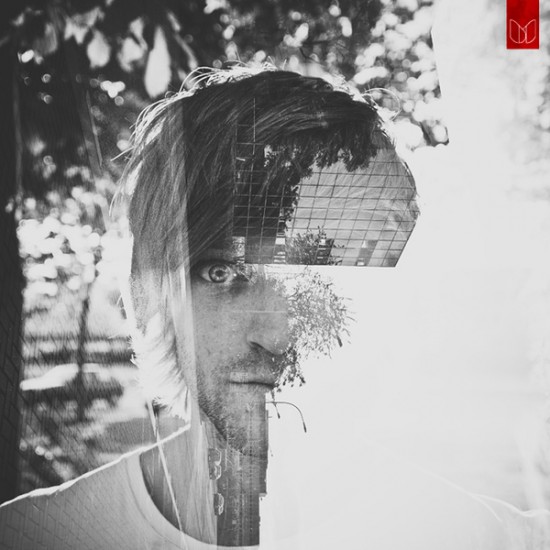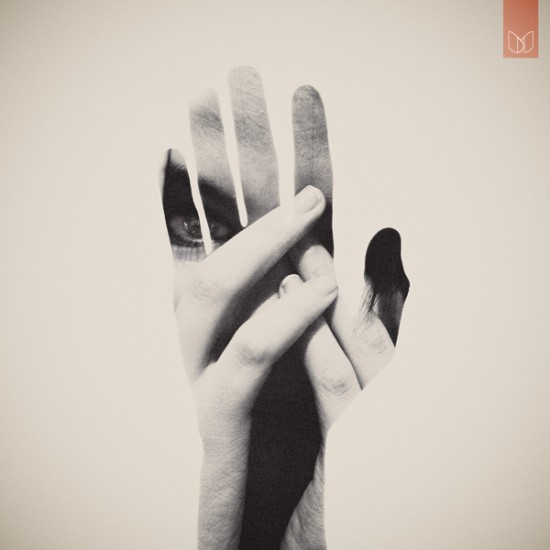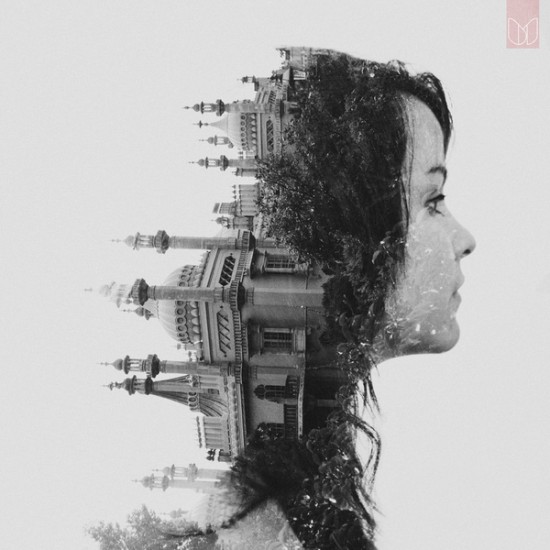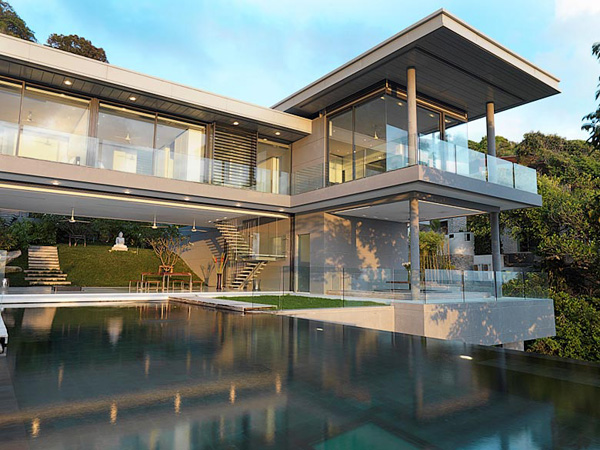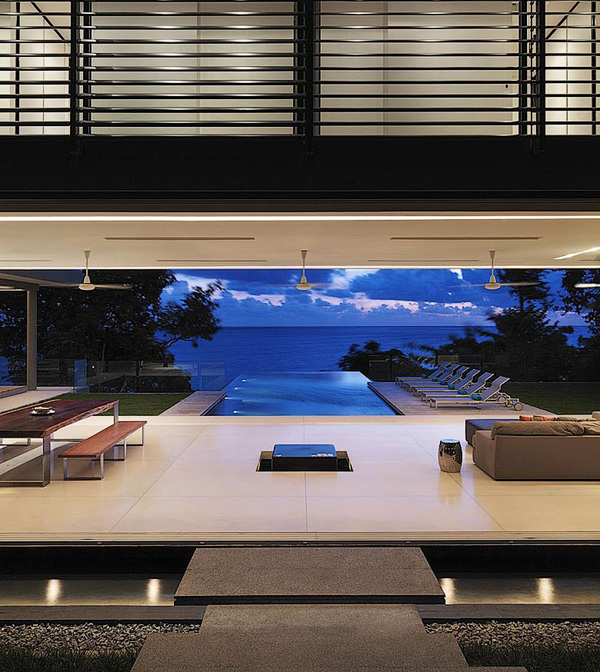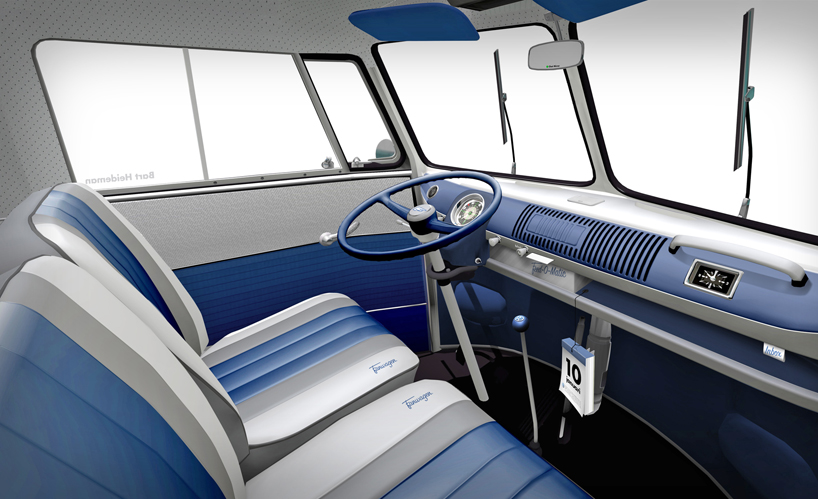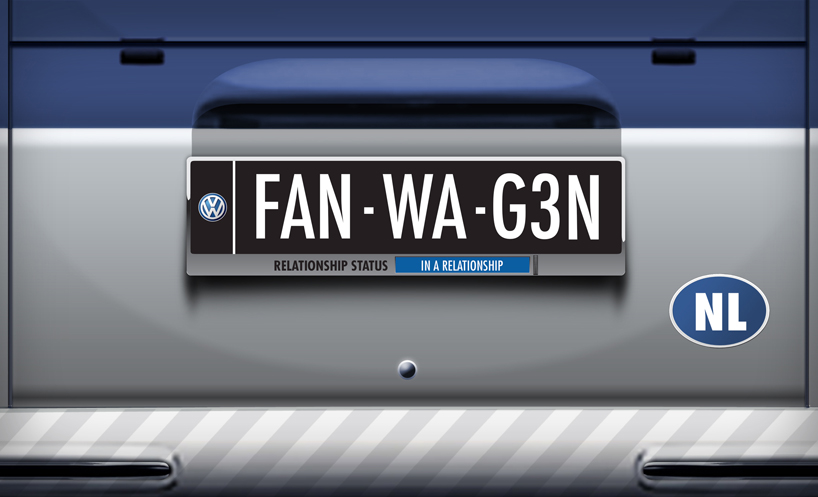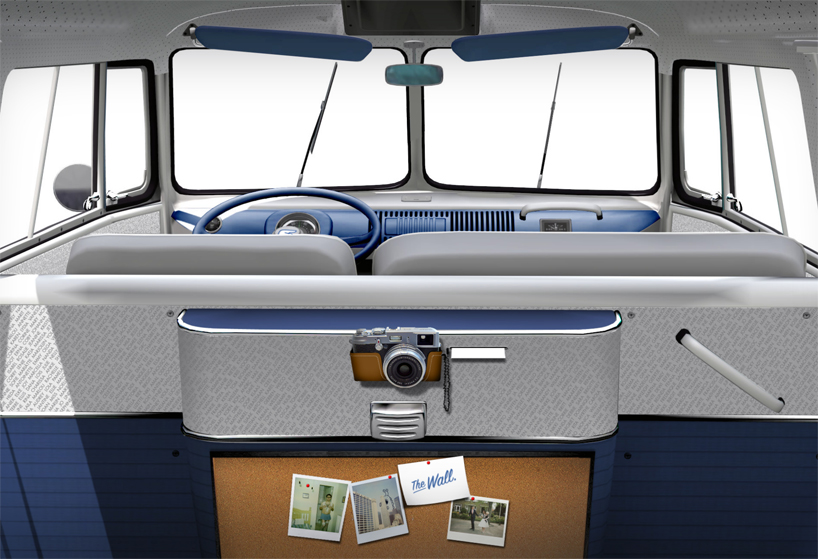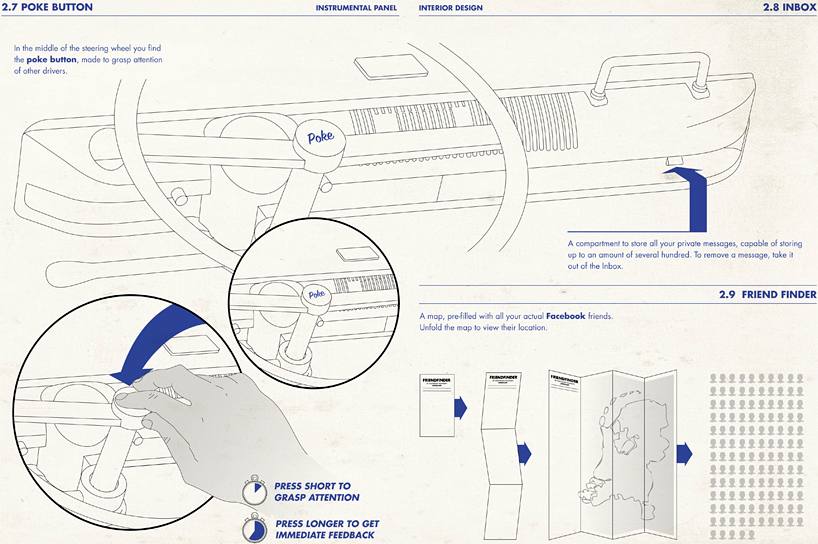Vacation house...
After finding the place I will live for most of the year in Thailand, I've found my vacation house in Madrid, Spain. And this one takes that top spot less because of location, and more for design. This house is one hundred percent round, a full 360 throughout the entire design. It is beautiful, and innovative; and another one of the many things that make me ask: Where do I get one?!
Nerdy Dirty, illustrations for nerds in love
This adorable little love illustrations are for the nerd I know is hidden deep inside every single on of us! It reminds me of the Big Bang Theory, the show that gets me through most projects, so it makes me love these even more. I love the use of flat washes of colour, with the small uses of typography in each of them just to add a little bit of humour to each of the illustrations.
source: www.dailyinspiration.nl
wonder-wall.com
Another website to blow your mind... and once you get past the sheer genius of their website design (and its extremely effective distracting techniques... I've been looking at it for an hour now...) you can check out their insanely modern and beautiful interior, architectural and product design. Now, go forth and have fun with this site!
Another website to blow your mind... and once you get past the sheer genius of their website design (and its extremely effective distracting techniques... I've been looking at it for an hour now...) you can check out their insanely modern and beautiful interior, architectural and product design. Now, go forth and have fun with this site!
My future house...
Sorry everyone, I think I'm going to have to leave, I'm moving to Phuket, Thailand. This villa is built into the granite rock face, and shows panoramic views of the Andaman Sea. Modern design at home in natural beauty.
Designed by Adrian McCarroll, Waiman Cheung & Jamie Jamieson.
Sorry everyone, I think I'm going to have to leave, I'm moving to Phuket, Thailand. This villa is built into the granite rock face, and shows panoramic views of the Andaman Sea. Modern design at home in natural beauty.
Designed by Adrian McCarroll, Waiman Cheung & Jamie Jamieson.
source:www.yankodesign.com
Fashion mixed with industrial or geometrical environments is something I respect and enjoy.
It brings the beauty of the person, and what they are wearing to the forefront, while increasing the awareness of thought about the picture. All round, beautiful.
source: www.mladenpenev.net
The evolution of logos
The Apple Logo, revolution. It takes you back to the original logo of Sir Isaac Newton sitting under the apple tree, and I'm sure he had no idea what the apple would become... a multi-billion dollar corporation with some of the best designs out there.
Again, another huge company, all about brand recognition. Its hard to believe that the logo has changed this much, and then gone back to something so similar to the original. The third logo is a shake my head moment, as in what were they really thinking with this, but they brought it back with the next design, and even more so with the most current. It just goes to show you that design follows trends just like everything else: if its good, it will come back into style.
And for my final example of logo evolution... IBM. This just shows a change in name and logo can work together really well. The first two are questionable on their intent, I have a hard time reading them, or getting anything out of them. I'm not sure whether is because I don't recognize the company, but I think it has a nice look with the lines and shapes, but is not effective as a logo. Working from there, the third has a cool concept, but is still hard to read in this small form. Going to the fourth, we are close to the current logo, with the simple use of typography to state the name of the company. I like both the fifth and sixth logo; they are clean and simple and recognizable, just like a logo should be.
source: www.inc.com
'like'
Volkswagen the Netherlands has taken the Volkswagen T1 bus and turned it into a Facebook advertising vehicle. It is one hundred percent Facebook, with different add ons and functions to fill every one of our Facebook-addicted selves needs. On the dashboard, this 'Fanwagon' features the 'feed-o-matic', a device that can print off the last ten post's of the drivers news feed, while only pushing one button. The rear license plate has a small scroll wheel to change the driver's relationship status, and come on, who wouldn't want to know then when you're driving? There's also a map in the car that can be programmed to show the locations of all the driver's friends... hello?... never use a gps again!
Some of the other features just play off a normal car's features; the horn is a 'poke' button, and within the manual it is "made to grasp the attention of other drivers". The door handles have labels that say "add friends", which is true: if I let you in my car, you either are or will be my friend! The glove compartment, or "inbox" is a 'feature' to "store all of your private messages"; with instructions included in the manual "to remove a message, take it out of the inbox". The user's manual also comes with instructions for privacy settings... 'all' (window curtains all the way open); 'friends only' (the curtains are to be pulled halfway); and 'only me' (the curtains are now shut). The rearview mirror is now the 'chat mirror' to "live chat with friends in the back seat: look in the mirror to see available friends, and select a specific friend by adjusting the angle of the mirror".
This design extremely well thought out, every little detail in the vehicle ties into the typical Facebook user perfectly, and lets all admit it, even if its not Facebook, every single one of us overuses a social networking site at least once in our lives. So its extremely applicable to most people. Now, my only question is: where do I get one?
Volkswagen the Netherlands has taken the Volkswagen T1 bus and turned it into a Facebook advertising vehicle. It is one hundred percent Facebook, with different add ons and functions to fill every one of our Facebook-addicted selves needs. On the dashboard, this 'Fanwagon' features the 'feed-o-matic', a device that can print off the last ten post's of the drivers news feed, while only pushing one button. The rear license plate has a small scroll wheel to change the driver's relationship status, and come on, who wouldn't want to know then when you're driving? There's also a map in the car that can be programmed to show the locations of all the driver's friends... hello?... never use a gps again!
Some of the other features just play off a normal car's features; the horn is a 'poke' button, and within the manual it is "made to grasp the attention of other drivers". The door handles have labels that say "add friends", which is true: if I let you in my car, you either are or will be my friend! The glove compartment, or "inbox" is a 'feature' to "store all of your private messages"; with instructions included in the manual "to remove a message, take it out of the inbox". The user's manual also comes with instructions for privacy settings... 'all' (window curtains all the way open); 'friends only' (the curtains are to be pulled halfway); and 'only me' (the curtains are now shut). The rearview mirror is now the 'chat mirror' to "live chat with friends in the back seat: look in the mirror to see available friends, and select a specific friend by adjusting the angle of the mirror".
This design extremely well thought out, every little detail in the vehicle ties into the typical Facebook user perfectly, and lets all admit it, even if its not Facebook, every single one of us overuses a social networking site at least once in our lives. So its extremely applicable to most people. Now, my only question is: where do I get one?
source: www.designboom.com
Scrabble takes on typography
This intense game of scrabble was designed by Andrew Capener. It was brought to life while he studied his last year at BYU, and it gives players a chance to mix up the boring old game of scrabble by adding new typefaces to each word. It makes the game so much more creative, with a crazy mix of letters in each word. I don't usually enjoy scrabble, I feel like I can never actually win the game, but with this game, who knows how much fun I would had? A new design can add a new perspective to just about anything.
He took the time to make the board out of solid walnut, with the pieces magnetized to stick together. The bottom of the board is lined with non-slip cork, and the entire system fits into a birch box.
I think this take of the game scrabble is really innovative, I really enjoy it when someone can take something known and trusted and spin it into something of a higher value and increase the interest at the same time. It's a beautiful piece that any collector, or just an everyday person would want on their coffee table.
source: www.design.is
Ten Steps, to becoming the designer you want to be
I like lists like this, they make you think about what you need to do, where you need to go, and how you're going to get there. Finding websites like this is always great, you never know what they will come out with after the first list.
1. Get the book
We all have a book that grabbed us by the throat and never let go, forever changing how we look at our profession. For me, that book was Sparks of Genius, The Thirteen Thinking Tools of the World's Most Creative People. The design process is, ultimately, the ability to creatively solve problems-and in our profession, we need to be better at it than most.
2. Get the obscure book you've never heard of
While it's an older book, The All New Universal Traveler – A soft-systems guide to creativity, problem solving and the process of reaching goals is still juicy today. It was written by architecture professors from California Polytech and the School of Architecture and Environmental Design, and presents a ton of research condensed into a tightly packed form.
3. Choose a topic that fascinates you and learn it inside out
This is how you become an expert. Your topic might be as broad as sustainability, or as narrow as a specific method like body storming. Over the last 10 years, I took on three provocative topics-emotional design, design research, and participatory design-and I just recently look on another: synesthesia.
4. Write, blog, and speak on that topic
You're an expert once you feel comfortable calling yourself an expert. Take Jakob Nielsen, who began blogging about usability back in the late 1990s. He became recognized as the source on usability because he was consistently churning out information on the topic. Were there other experts on usability? Sure. But Nielsen developed the early point of view, and wrote provocatively about the subject.
5. Learn Something New Every Day
Every designer should be on a quest to see the world with fresh eyes every day. This might be learning something-a bit of trivia, perhaps-that helps you see the world a little differently. For example, today I learned that cats can't taste sugar. This may sound trivial, but it could lead to a whole host of ideas. And so could the fact that they have hooks on their tongue to lap up water.
6. Create a New Idea Every Day
At one point I was twittering a new idea every day. (Example: "Product Idea #1: Skin Pens > did you ever write notes on your hand? i still do. i want a pen for skin writing on the go.") Now I file them manually. People will say that ideas are a dime a dozen, but I think they're wrong: I think the first 10 might be worth a dime, but the last two could be worth their weight in gold. I would suggest that the designer without an idea isn't a designer. Record them, capture them, and go back to them.
7. Experiment
Good designers experiment. One of my favorite examples is from fellow frog Michael McDaniel, who conceived of portable housing after Hurricane Katrina. When he didn't get immediate interest from government agencies, he built a full prototype in his backyard. I've experimented with measuring emotion through sound, and a scent alphabet, to name a few. When you do experiment, push the edges.
8. Learn as many frameworks as you can
In 2008, a design team at M3 (where I was working at the time) went through 400 design research methods, reduced the redundancy, and then sorted the remaining 250. This exercise, while daunting, was incredible: For the first time, a designer could see the research methods, or "frameworks," that existed in the design space. The point is, you should get comfortable moving beyond just brainstorming and start structuring data in such a way that it drives insight and innovation. When you get comfortable with many frameworks, you'll start creating your own. The only caveat is not to rely on them, because not everything can be modeled in a framework that already exists.
9. Choose variety over anything else
I turned down an offer that paid more to come work at frog. I've never regretted that decision. If anything, frog has made me crave variety in such a way that I doubt I'll ever be able to commit to just one industry. I've done everything from cell phone interaction design to social networking strategy, and from the future of electric vehicles to emotional medical identification. I would recommend to anyone that when you stop learning, it's time to move on.0
10. Model or draw (all the f*@#ing time)
To be good at anything, you need to do it a lot. And to be really, really good, you need to do it all the time. I don't care how great an idea is, if you can't model it, prototype it, or draw it, then you're screwed. If you learn nothing else from this blog post, please find a way to learn how to make your ideas tangible. This can be through graphic design, sketching and rendering in Alias, a flash prototype, photography, video, whatever. Just learn the tools of the tangible.
(source:www.good.is)
I like lists like this, they make you think about what you need to do, where you need to go, and how you're going to get there. Finding websites like this is always great, you never know what they will come out with after the first list.
1. Get the book
We all have a book that grabbed us by the throat and never let go, forever changing how we look at our profession. For me, that book was Sparks of Genius, The Thirteen Thinking Tools of the World's Most Creative People. The design process is, ultimately, the ability to creatively solve problems-and in our profession, we need to be better at it than most.
2. Get the obscure book you've never heard of
While it's an older book, The All New Universal Traveler – A soft-systems guide to creativity, problem solving and the process of reaching goals is still juicy today. It was written by architecture professors from California Polytech and the School of Architecture and Environmental Design, and presents a ton of research condensed into a tightly packed form.
3. Choose a topic that fascinates you and learn it inside out
This is how you become an expert. Your topic might be as broad as sustainability, or as narrow as a specific method like body storming. Over the last 10 years, I took on three provocative topics-emotional design, design research, and participatory design-and I just recently look on another: synesthesia.
4. Write, blog, and speak on that topic
You're an expert once you feel comfortable calling yourself an expert. Take Jakob Nielsen, who began blogging about usability back in the late 1990s. He became recognized as the source on usability because he was consistently churning out information on the topic. Were there other experts on usability? Sure. But Nielsen developed the early point of view, and wrote provocatively about the subject.
5. Learn Something New Every Day
Every designer should be on a quest to see the world with fresh eyes every day. This might be learning something-a bit of trivia, perhaps-that helps you see the world a little differently. For example, today I learned that cats can't taste sugar. This may sound trivial, but it could lead to a whole host of ideas. And so could the fact that they have hooks on their tongue to lap up water.
6. Create a New Idea Every Day
At one point I was twittering a new idea every day. (Example: "Product Idea #1: Skin Pens > did you ever write notes on your hand? i still do. i want a pen for skin writing on the go.") Now I file them manually. People will say that ideas are a dime a dozen, but I think they're wrong: I think the first 10 might be worth a dime, but the last two could be worth their weight in gold. I would suggest that the designer without an idea isn't a designer. Record them, capture them, and go back to them.
7. Experiment
Good designers experiment. One of my favorite examples is from fellow frog Michael McDaniel, who conceived of portable housing after Hurricane Katrina. When he didn't get immediate interest from government agencies, he built a full prototype in his backyard. I've experimented with measuring emotion through sound, and a scent alphabet, to name a few. When you do experiment, push the edges.
8. Learn as many frameworks as you can
In 2008, a design team at M3 (where I was working at the time) went through 400 design research methods, reduced the redundancy, and then sorted the remaining 250. This exercise, while daunting, was incredible: For the first time, a designer could see the research methods, or "frameworks," that existed in the design space. The point is, you should get comfortable moving beyond just brainstorming and start structuring data in such a way that it drives insight and innovation. When you get comfortable with many frameworks, you'll start creating your own. The only caveat is not to rely on them, because not everything can be modeled in a framework that already exists.
9. Choose variety over anything else
I turned down an offer that paid more to come work at frog. I've never regretted that decision. If anything, frog has made me crave variety in such a way that I doubt I'll ever be able to commit to just one industry. I've done everything from cell phone interaction design to social networking strategy, and from the future of electric vehicles to emotional medical identification. I would recommend to anyone that when you stop learning, it's time to move on.0
10. Model or draw (all the f*@#ing time)
To be good at anything, you need to do it a lot. And to be really, really good, you need to do it all the time. I don't care how great an idea is, if you can't model it, prototype it, or draw it, then you're screwed. If you learn nothing else from this blog post, please find a way to learn how to make your ideas tangible. This can be through graphic design, sketching and rendering in Alias, a flash prototype, photography, video, whatever. Just learn the tools of the tangible.
(source:www.good.is)
Check this out... visualdata.org
I love interactive websites, and this one has several levels of ways to interact. Check through the series of pages at the bottom, each one is a different program to work with. The only problem is, its not a great site to find when you have too much to do!
I love interactive websites, and this one has several levels of ways to interact. Check through the series of pages at the bottom, each one is a different program to work with. The only problem is, its not a great site to find when you have too much to do!
Subscribe to:
Posts (Atom)







